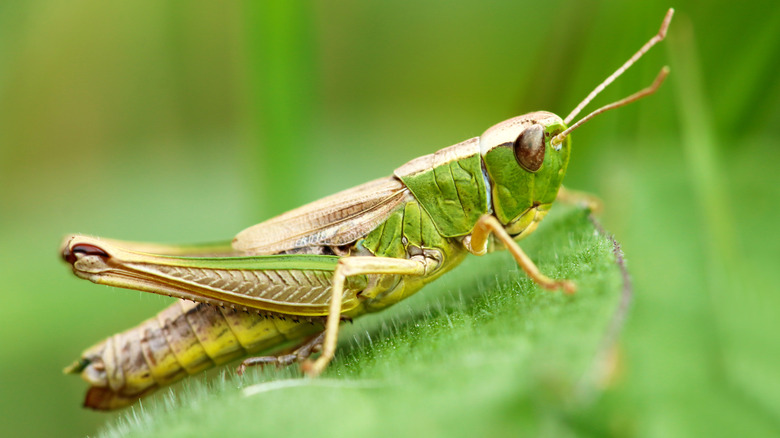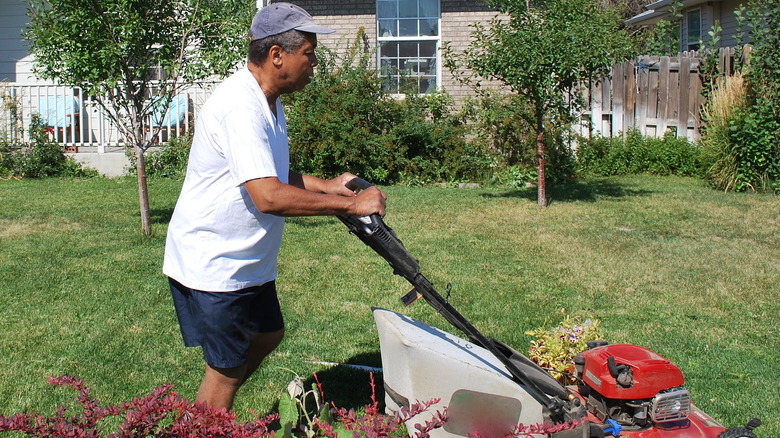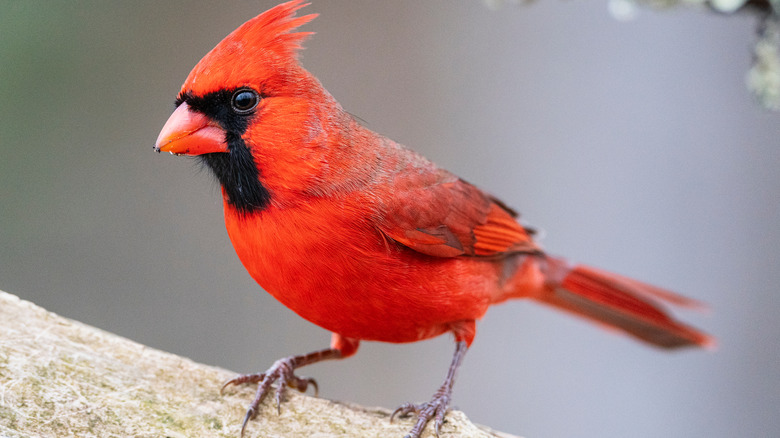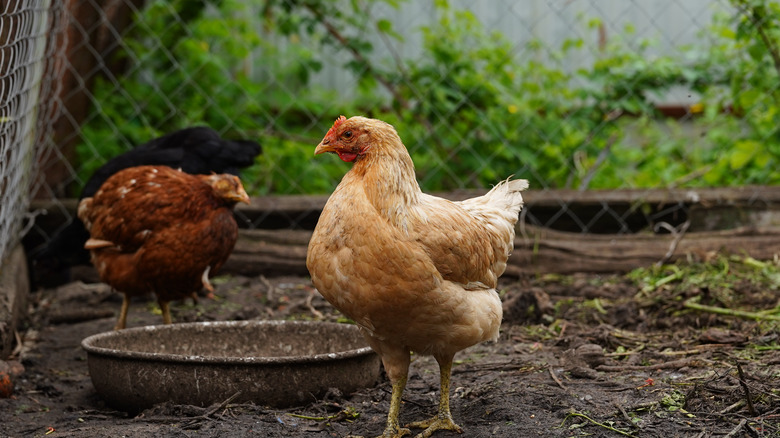8 Best Ways To Get Rid Of Grasshoppers
We may receive a commission on purchases made from links.
It's no secret that grasshoppers can be a major menace when it comes to a flourishing garden. According to The Spruce, these hoppity creatures adore a variety of options that could be growing in your garden, including sweet corn, alfalfa, rice, grasses, lettuce, and even onions. The outlet notes that about 30 kinds of grasshoppers of around 600 can wreak havoc on plants in a garden.
Grasshoppers can be a nuance for small backyard gardeners or a problem for farmers producing on vast lands. "I can only describe grasshoppers in expletives," says Roger Nicholson, a cattle rancher in Fort Klamath to The Guardian. "They are a scourge of the Earth ... They just destroy the land, destroy the crops. They are just a bad, bad predator."
Luckily, if you have had a run-in with an unsightly grasshopper infestation, we have found eight of the best ways to eliminate these plant-eating creatures. Read on to find the best method for you!
1. Mow the lawn
One of the things you can do to get rid of a growing population of grasshoppers in your yard is to mow your lawn, which — let's be honest, will also keep your neighbors happy. Yes, it can be that easy! As USA Today points out, how often you mow your lawn depends on where you live geographically, but generally once a week will do the trick. Allyn Hane, a DIY lawn care professional known as the Lawn Care Nut on Youtube, shared with the outlet, "The more you mow, the healthier your lawn will grow." Grasshoppers love an overgrown yard with tall grass, so there are some benefits to maintaining a kept yard.
Plus, according to The Spruce, newly hatched grasshopper nymphs will eat weeds, so make sure to clear these out. You are getting rid of their food source, thus limiting the population in your garden, so it's another reason to get your hands dirty.
2. Till your garden's soil
It turns out that tilling your garden's soil has a few additional benefits besides prepping it for planting. "Garden tilling is an essential process if you want to add a considerable amount of organic matter to make the soil more fertile, or if you need to prepare a garden bed for fresh seedings," says The Bumper Crop Times gardening expert Bryan McKenzie to the Family Handyman. Additionally, Outdoor Happens expert gardener Elle Meager explains to the Family Handyman, "Roots and plants hate thick, hard, clumped-up soil. That's because plants need plenty of oxygen, nutrients, and moisture — all of which are hard to come by if the dirt is hard as a rock. When you break up the soil with tilling, your plants have more of a chance to take root, flourish, access oxygen, and develop without stress."
That can be good news for your garden in general, as well as bad news for pests like grasshoppers; Bulwark Exterminating says you can kill off eggs to eliminate a grasshopper infestation with this tip. In the spring, be sure to till your soil to destroy any eggs laid the previous summer.
3. Attract birds to your garden
One way to keep grasshoppers away is to naturally bring in things that love to eat them. To that end, making your garden a magnet for beautiful birds isn't just something you may enjoy watching on a Saturday morning; you may love seeing birds bathe in a birdbath or nip at birdseed, but birds also adore munching on grasshoppers — especially Bluebirds, Cardinals, Orioles, and Swallows, according to Gardener's Supply Company. Birds are excellent at controlling pests in the garden, including earwigs, whiteflies, and grasshoppers.
The Spruce has an excellent tip if you have a garden near an overgrown area (think a meadow or the woods): They say that if you mow the grass circling your garden at about 6 feet wide, this gives grasshoppers no place to hide, rendering it the perfect spot for birds or other grasshopper eaters to spot them. There are also other predators that naturally love to eat grasshoppers, including rodents, spiders, lizards, mantids, and frogs.
4. Get chickens
To us, there are definitely some excellent benefits of getting chickens that can easily take up residence in your home's spacious backyard! If you're seriously considering this option, be sure to check your local laws, with BackYardChickens.com being a beneficial resource. You'll get a lovely assortment of fresh eggs to enjoy for breakfast every single day, and they will keep your population of grasshoppers at bay (who knew?). In fact, according to the Chicago Botanic Garden, chickens are incredibly fond of chasing down grasshoppers and making them a delicious snack, along with other pests that destroy your gardens, such as grubs, beetles, and larvae.
Another excellent reason why you may want to consider getting chickens? According to Hobby Farms, they will also eat scorpions, spiders, centipedes, termites, and ticks, so it just might be an intelligent solution to keeping many pests outside of your home where they belong.
5. DIY garlic spray
If you would like to get rid of grasshoppers from your garden, SF Gate showcases how you could easily do that by creating a garlic spray since they dislike garlic. The outlet advises that you bring 10 cups of water to a boil and mix in two crushed garlic bulbs. Then, allow this mixture to rest throughout the night while you get your shut-eye. In the morning, simply add this mixture to a spray bottle.
If you would rather purchase your garlic spray, that is also an option. Garlic Barrier Insect Repellent White helps ward off grasshoppers (and mosquitoes). However, one reviewer wished they would have gone the DIY route, saying, "What I did not expect [was] the extremely strong and awful smell generated even by the closed container. I stored it in the garage, and the smell was unbearable. I removed it from the garage, and the smell still lingers three days later. I would have been better off boiling my own garlic and using the resulting liquid and throwing away what was left."
6. Make a trap
One idea to get rid of an infestation of grasshoppers is to trap them and remove them from your home. According to Get Lost Pest Control, you can drown the grasshoppers by adding one part molasses (which lures grasshoppers) to a bucket containing 10 parts water. After that, you can repeat the process until the grasshoppers are eliminated.
Pesticide.org says that you can also cut the top off of a bottle and then put grass at the bottom to trap grasshoppers inside for a more humane option. They also say that if you find that grasshoppers have entered your home, sticky traps are an excellent option, available at most home improvement stores or online sites like Amazon. One purchaser places the Catchmaster 72MAX Pest Trap on his windowsill to brilliantly trap grasshoppers before they invade the house, while another reviewer uses the product in the basement with satisfying results.
7. Use apple cider vinegar
According to Hunker, another way to kill grasshoppers and eliminate them from your garden is to make an apple cider vinegar spray. First, locate an empty insecticide tank sprayer such as the Bob Vila recommended CHAPIN 20000 Garden Sprayer 1 Gallon Lawn and have that standing by as you mix your ingredients together. Then, get a bowl and in it mix three parts water, one part apple cider vinegar, and 5 grams of soap flakes (such as the eco-friendly, pure Soap Granule Flakes by the Pure Organic Ingredients store on Amazon).
Once you are done and have added your DIY spray to the garden sprayer, you are ready to douse your plant's leaves with the solution, ideally during the morning hours. Hunker offers an excellent tip, saying to hang onto the deceased grasshoppers for food for birds, which they say is safe for them to ingest.
8. Boric acid
Finally, SF Gate says that boric acid is an ideal natural solution for eliminating persistent grasshoppers. They suggest sprinkling the edges of your vegetable garden with the powdery substance. Then, sit back and watch as it successfully repels grasshoppers and other garden annoyances such as ants. A bonus? It is a safe alternative if you have a home where kids and pets live.
As Keith McCoy, VP of sales for Solutions Pest & Lawn, explains, "The saying 'a little goes a long way' is spot on when it comes to boric acid treatment. When applying boric acid, you should apply in a way that you hardly see anything coming out with your naked eyes. This is the reason why it's better to use a handheld duster because you'll get nice controlled little puffs of dust that will hardly be seen, but it will be sufficient enough to do damage to unsuspecting insects."








